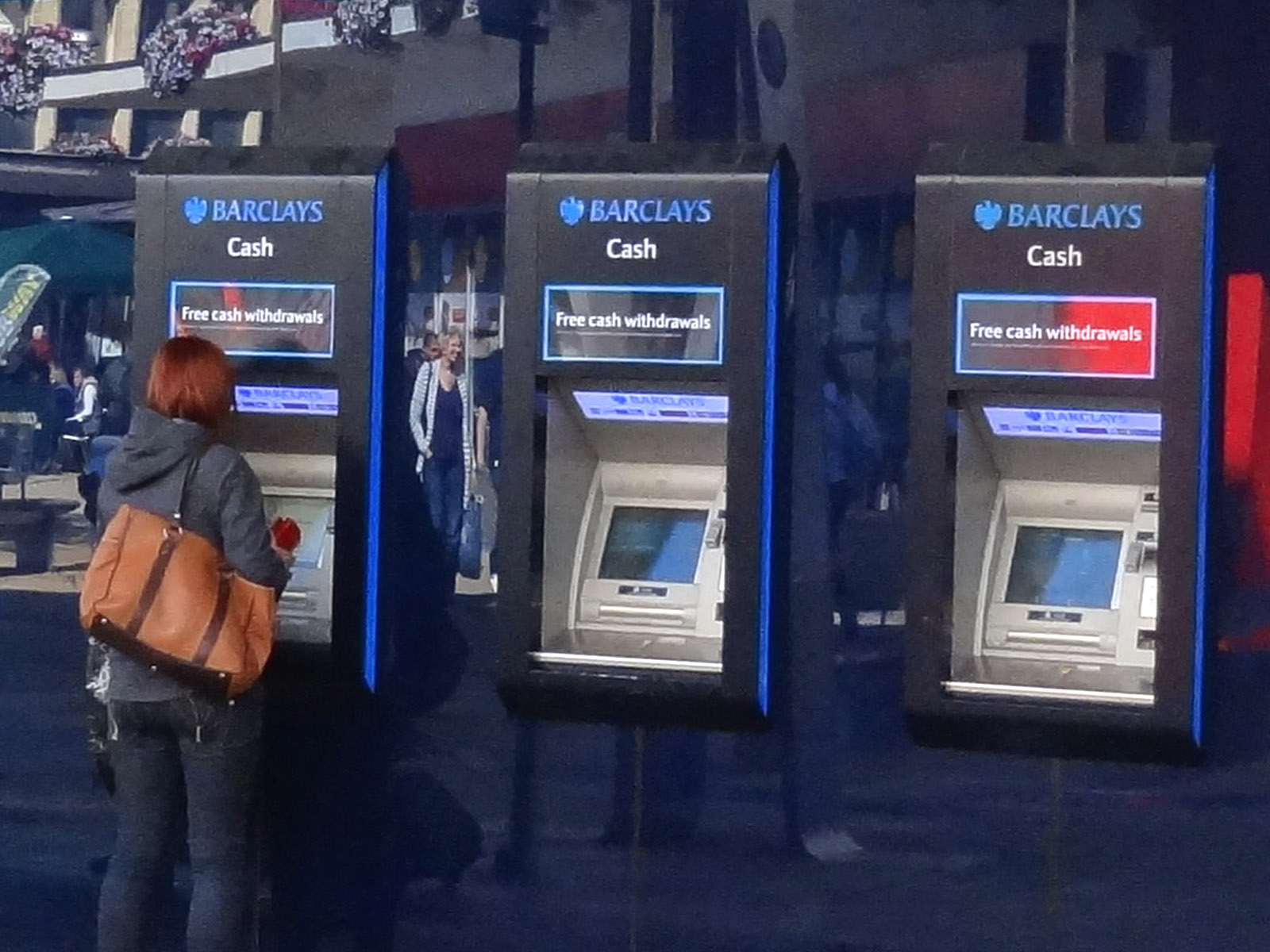 Latest data from the UK banking trade association, UK Finance, show that cash payments have continued to decline, while contactless and mobile payments have risen dramatically. In 2018, cash payments fell 16% to 11.0 billion payments and constituted just 28% of total payments; the compares with 60% in 2008 and a mere 9% projected for 2028. By contrast, in 2018, debit card payments increased 14% to 15.1 billion payments. Credit card payments increased 4% to stand at 3.2 billion payments. Mobile payments though media such as Apple Pay, Google Pay and Samsung Pay, although still a relatively small percentage, have also increased rapidly, with 16% of the adult population registered for mobile payments, compared with just 2% in 2016.
Latest data from the UK banking trade association, UK Finance, show that cash payments have continued to decline, while contactless and mobile payments have risen dramatically. In 2018, cash payments fell 16% to 11.0 billion payments and constituted just 28% of total payments; the compares with 60% in 2008 and a mere 9% projected for 2028. By contrast, in 2018, debit card payments increased 14% to 15.1 billion payments. Credit card payments increased 4% to stand at 3.2 billion payments. Mobile payments though media such as Apple Pay, Google Pay and Samsung Pay, although still a relatively small percentage, have also increased rapidly, with 16% of the adult population registered for mobile payments, compared with just 2% in 2016.
But what are the implications of this ‘dash from cash’? On the plus side, clearly there are advantages to consumers. A contactless payment is often more convenient than cash and does not require periodic visits to a cash machine (ATM) – machines that are diminishing in number and may be some distance away if you live in the countryside. What is more, card payments allow purchasing online – a form of shopping that continues to grow. Also, if a card is stolen or lost, you can cancel it; if cash is stolen or lost, you cannot cancel that.
 Then there are benefits to vendors. Cashing up is time consuming and brings little or no benefit in terms of bank charges. These are typically around 0.75% for cash deposits and roughly the same for handling debit card payments (around 0.7%). What is more, with the closure of many bank branches, it is becoming harder for many businesses to deposit cash.
Then there are benefits to vendors. Cashing up is time consuming and brings little or no benefit in terms of bank charges. These are typically around 0.75% for cash deposits and roughly the same for handling debit card payments (around 0.7%). What is more, with the closure of many bank branches, it is becoming harder for many businesses to deposit cash.
Finally, there is the problem that many illegal activities involve cash payments. What is more, cash payments can be used as a means of avoiding tax as they can be ‘kept off the books’.
But there are also dangers in the dash from cash. Although the majority of people now use cards for at least some of their transactions, many older people and people on low incomes rely on cash and do not use online banking. With bank branches and ATMs closing, this group is becoming further disadvantaged. As the Access to Cash Review, Final Report states:
Millions of people could potentially be left out of the economy, and face increased risks of isolation, exploitation, debt and rising costs.
Then there is the danger of fraud. As the Financial Times article below states:
The proliferation of new types of payment method has raised concerns over security. Criminals stole £1.2bn in 2018, according to previous data from UK Finance, up from £967m in 2017. This included a rise in fraudsters illegally accessing customers’ accounts and cards.
Complaints about banking scams reached a record high in the past financial year, according to figures in May from the UK’s Financial Ombudsman Service.
One of the biggest dangers, however, of the move to card payments, and especially contactless payments, is that people may be less restrained in their spending. They may be more likely to rack up debt with little concern at the time of spending about repayment. As the Forbes article below states:
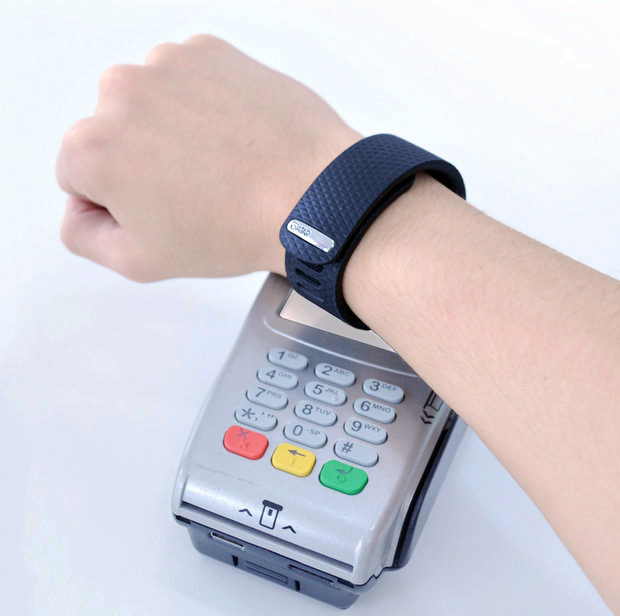 Because items purchased with a credit card have been decoupled from emotion, shoppers can focus on the benefits of the purchase instead of the cost. Thus, paying with a credit card makes it more difficult to focus on the cost or complete a more rational cost–benefit analysis. For example, if a person had to count out $0.99 to purchase an app, they might be less inclined to buy it. However, since we can quickly buy apps with our credit card, the cost seems negligible, and we can focus on the momentary happiness of the purchase.
Because items purchased with a credit card have been decoupled from emotion, shoppers can focus on the benefits of the purchase instead of the cost. Thus, paying with a credit card makes it more difficult to focus on the cost or complete a more rational cost–benefit analysis. For example, if a person had to count out $0.99 to purchase an app, they might be less inclined to buy it. However, since we can quickly buy apps with our credit card, the cost seems negligible, and we can focus on the momentary happiness of the purchase.
Finally, there is the issue of our privacy. Card payments enable companies, and possibly other agencies, to track our spending. This may have the benefits of allowing us to receive tailored advertising, but it may be used as a way of driving sales and encouraging us to take on more debt as well as giving companies a window on our behaviour.
Articles
- Millions choose a cashless lifestyle
BBC News, Kevin Peachey (6/6/19)
- The decline of cash in the UK – in charts
BBC News (7/6/19)
- One in 10 adults in UK have gone ‘cashless’, data shows
The Guardian, Rupert Jones (6/6/19)
- Going contactless is gloriously convenient – for all the wrong people
The Guardian, Peter Ormerod (7/3/19)
- Mobile banking and contactless cards continue to surge in popularity
Financial Times, James Pickford (6/6/19)
- Is a cashless society in Britain near? Banking data suggests just 9% of all payments will be cash by 2028
This is Money, George Nixon (6/6/19)
- Older and poorer communities are left behind by the decline of cash
The Conversation, Daniel Tischer, Jamie Evans and Sara Davies (16/5/19)
- As cash declines, research shows the most deprived communities are left behind
University of Bristol Press Release (16/5/19)
- Do People Really Spend More With Credit Cards?
Forbes, Bill Hardekopf (16/7/18)
- Why Cash Is Quickly Disappearing From China’s Economy—Data Sheet
Fortune, Aaron Pressman and Clay Chandler (5/6/19)
 Cashless in China: Why It Matters
Cashless in China: Why It Matters CNA Insider on YouTube, Joshua Lim (28/10/17)
Reports
Questions
- Summarise the main findings of the UK Payments Market Report 2019
- What are the relative merits of using (a) cash; (b) debit cards; (c) mobile payment?
- Find out what has happened to consumer debt in a country of your choice over the past five years. What are the main determinants of the level of consumer debt?
- How has UK money supply changed over the past five years? To what extent does this reflect changes in the ways people access money in their accounts?
- Why and how is China going ‘cashless’? Does this create any problems?
- Make out a case for and against increasing the £30 limit for contactless payments in the UK.
 If you asked virtually any banker or economist a few years ago whether negative (nominal) interest rates were possible, the answer would almost certainly be no.
If you asked virtually any banker or economist a few years ago whether negative (nominal) interest rates were possible, the answer would almost certainly be no.
Negative real interest rates have been common at many points in time – whenever the rate of inflation exceeds the nominal rate of interest. People’s debts and savings are eroded by inflation as the interest due or earned does not keep pace with rising prices.
But negative nominal rates? Surely this could never happen? It was generally believed that zero (or slightly above zero) nominal rates represented a floor – ‘a zero lower bound’.
The reasoning was that if there were negative nominal rates on borrowing, you would effectively be paid by the bank to borrow.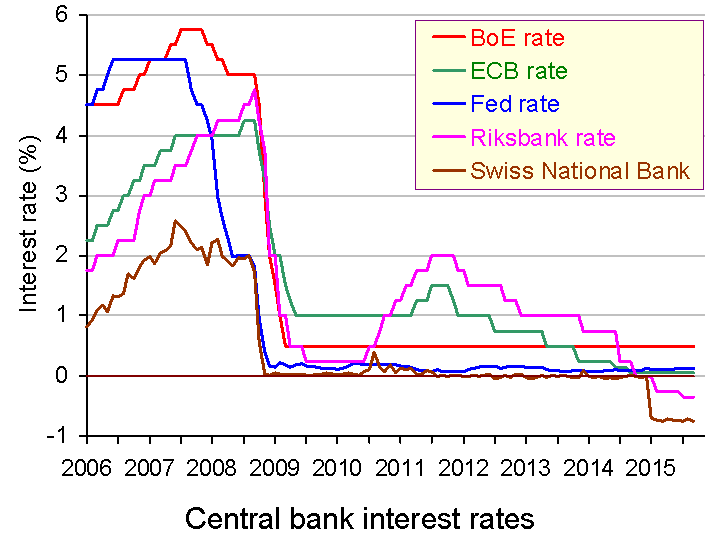 In such a case, you might as well borrow as much as you can, as you would owe less later and could pocket the difference.
In such a case, you might as well borrow as much as you can, as you would owe less later and could pocket the difference.
A similar argument was used with savings. If nominal rates were negative, savers might as well withdraw all their savings from bank accounts and hold them as cash (perhaps needing first to buy a safe!) Given, however, that this might be inconvenient and potentially costly, some people may be prepared to pay banks for looking after their savings.
Central bank interest rates have been hovering just above zero since the financial crisis of 2008. And now, some of the rates have turned negative (see chart above). The ECB has three official rates:
|
|
| • |
The interest rate on the main refinancing operations (MRO), which provide the bulk of liquidity to the banking system. |
| • |
The rate on the deposit facility, which banks may use to make overnight deposits with the Eurosystem. |
| • |
The rate on the marginal lending facility, which offers overnight credit to banks from the Eurosystem. |
The first of these is the most important rate and remains above zero – just. Since September 2014, it has been 0.05%. This rate is equivalent to the Bank of England’s Bank Rate (currently still 0.5%) and the Fed’s Federal Funds Rate (currently still between 0% and 0.25%).
The third of the ECB’s rates is currently 0.3%, but the second – the rate on overnight deposits in the ECB by banks in the eurozone – is currently –0.2%.  In other words, banks have to pay the ECB for making these overnight deposits (deposits that can be continuously rolled over). The idea has been to encourage banks to lend rather than simply keeping unused liquidity.
In other words, banks have to pay the ECB for making these overnight deposits (deposits that can be continuously rolled over). The idea has been to encourage banks to lend rather than simply keeping unused liquidity.
In Nordic countries, the experiment with negative rates has gone further. With plenty of slack in the Swedish economy, negative inflation and an appreciating krona, the Swedish central bank – the Riksbank – cut its rates below zero.
Many City analysts believe that the Riksbank will continue cutting, reducing its key interest rate to minus 0.5% by the end of the year [it is currently 0.35%]. Switzerland’s is already deeper still, at minus 0.75%, while Denmark and the eurozone have joined them as members of the negative zone.
But the nominal interest rate on holding cash is, by definition, zero. If deposit rates are pushed below zero, then will more and more people hold cash instead?  The hope is that negative nominal interest rates on bank accounts will encourage people to spend. It might, however, merely encourage them to hoard cash.
The hope is that negative nominal interest rates on bank accounts will encourage people to spend. It might, however, merely encourage them to hoard cash.
The article below from The Telegraph looks at some of the implications of an era of negative rates. The demand for holding cash has been increasing in many countries and, along with it, the supply of banknotes, as the chart in the article shows. Here negative interest are less effective. In Nordic countries, however, the use of cash is virtually disappearing. Here negative interest rates are likely to be more effective in boosting aggregate demand.
Article
How Sweden’s negative interest rates experiment has turned economics on its head The Telegraph, Peter Spence (27/9/15)
Data
Central bank and monetary authority websites Bank for International Settlements
Central banks – summary of current interest rates global-rates.com
Questions
- Distinguish between negative real and negative nominal interest rates.
- What is the opportunity cost of holding cash – the real or the nominal interest rate forgone by not holding it in a bank?
- Are there any dangers of central banks setting negative interest rates?
- Why may negative interest rates be more effective in Sweden than in the UK?
- ‘Andy Haldane, a member of the Monetary Policy Committee (MPC) … suggested that to achieve properly negative rates, the abolition of cash itself might be necessary.’ Why?
- Why does Switzerland have notes of SF1000 and the eurozone of €500? Should the UK have notes of £100 or even £500?
- Why do some banks charge zero interest rates on credit cards for a period of time to people who transfer their balances from another card? Is there any incentive for banks to cut interest rates on credit cards below zero?
 A recent article on this blog discussed the likelihood that we will soon move to a cashless society. It is therefore interesting to consider the implications that this might have for consumer behaviour. We might expect the form of payment to make no difference to a rational consumer. However, there is considerable evidence to suggest that this is not the case.
A recent article on this blog discussed the likelihood that we will soon move to a cashless society. It is therefore interesting to consider the implications that this might have for consumer behaviour. We might expect the form of payment to make no difference to a rational consumer. However, there is considerable evidence to suggest that this is not the case.
One reason why people appear to spend more freely on credit cards is payment decoupling – you get utility from the item purchased before you pay the cost. However, more recent evidence suggests that this is not the only relevant factor. It appears that the degree of transparency of the payment method also has an effect. Psychologists quoted in the above article conclude from their experimental evidence that:
Payment modes differ in the transparency with which individuals can feel the outflow of money. ….with cash being the most transparent payment mode.
This effect also appears to make people spend cash less freely.
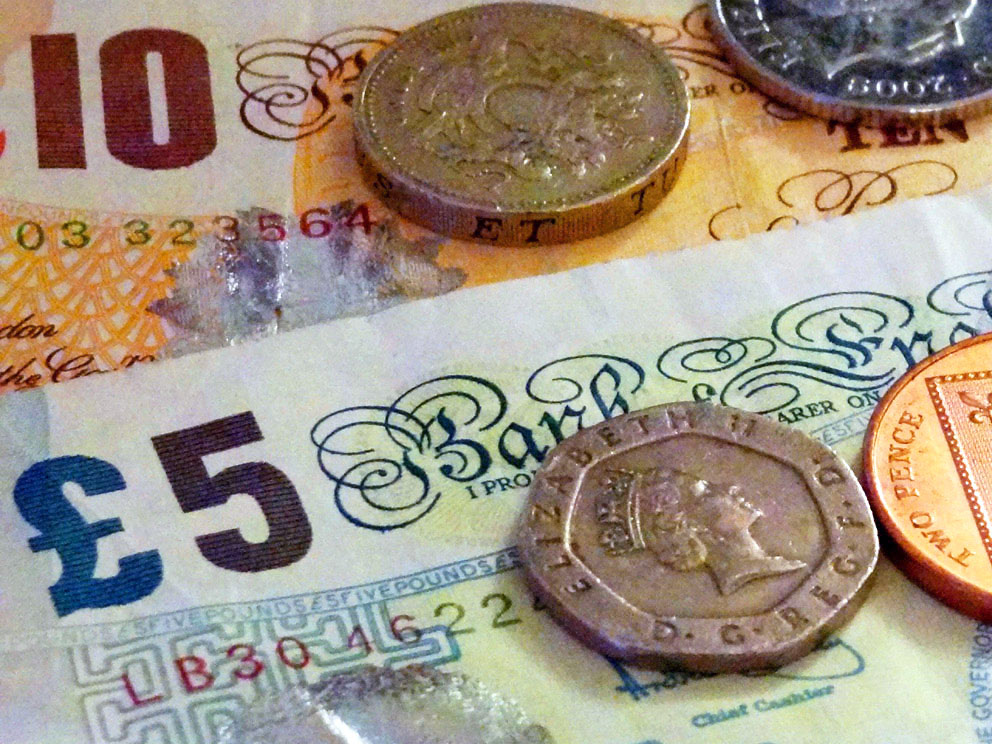 The author of the above article spent some time experimenting with trying to make all his purchases using cash. He found that by doing so, he was able to reduce his spending by about 10%. However, this seems likely to become harder to do in the future and, as the article concludes, it is already difficult to purchase some items with cash.
The author of the above article spent some time experimenting with trying to make all his purchases using cash. He found that by doing so, he was able to reduce his spending by about 10%. However, this seems likely to become harder to do in the future and, as the article concludes, it is already difficult to purchase some items with cash.
Article
Why does foreign money seem like play money? Science Codex (04/06/07)
Questions
- What type of products is it already difficult to purchase with cash?
- How did the psychologists test the transparency of payment methods?
- Do you think the consumer behaviour described above is likely to persist in the long-run?
- Might firms be able to take advantage of the consumers behave described above?
- Do you think the transparency of foreign currencies is the main reason why people spend more when they are abroad?
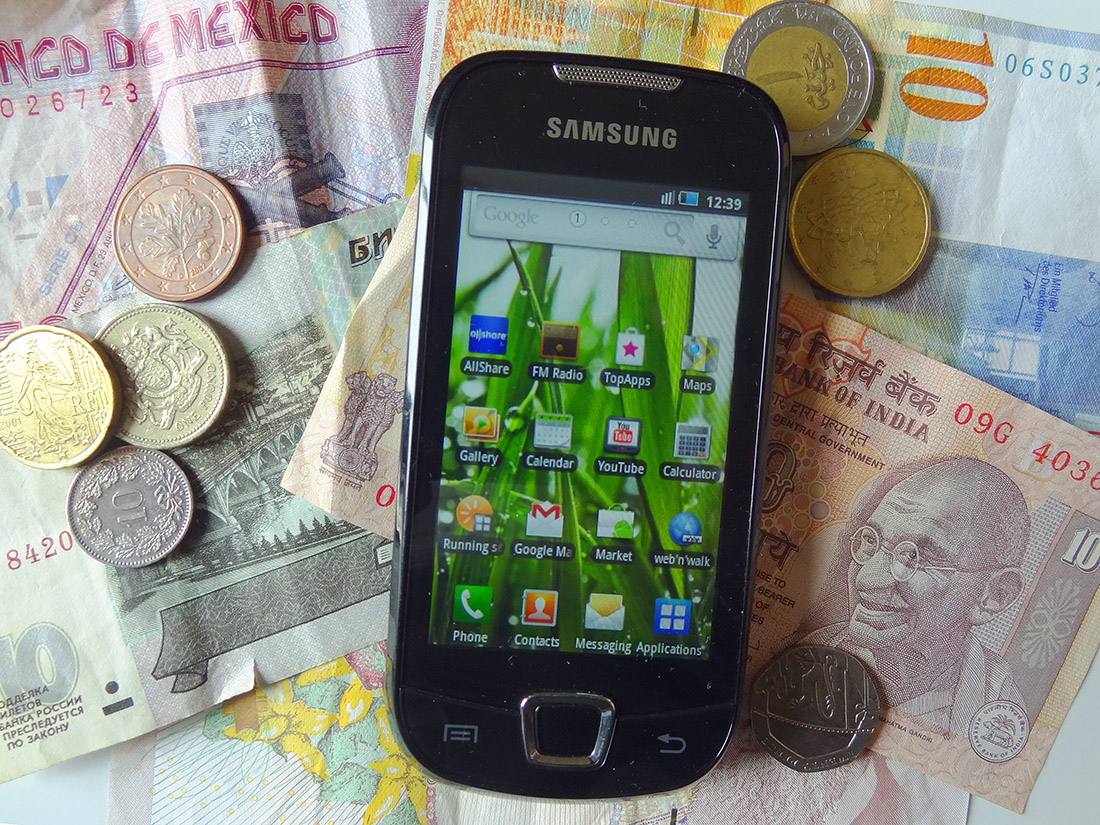 Will we soon live in a world without cash? More and more payments are being made electronically: whether by credit card or debit card, or by direct debit or bank transfer, or by cash loaded cards. For many people cash is now largely used only for small transactions.
Will we soon live in a world without cash? More and more payments are being made electronically: whether by credit card or debit card, or by direct debit or bank transfer, or by cash loaded cards. For many people cash is now largely used only for small transactions.
But even here, things are changing. Direct transfers via mobile phone apps are increasingly being used for small transactions. Mobile phone companies, banks and others are busy developing such apps and more and more are being released onto the market.
And it’s not just in developed countries. Many developing countries are finding that mobile phones are an ideal way of transferring money for a whole range of transactions. For example, in Kenya, under 20% have a formal bank account, only 1% have a landline and yet more than 70% have a mobile phone, and this percentage is still rising. In 2007, a system known as M-Pesa (see also) was launched:
The user can create a free account and deposit money into it for free with registered agents at retail outlets. They may be gas stations, supermarkets, banks or micro-finance providers or small and medium-sized businesses. No minimum account balance is required.
The user can then transfer up to $440 from the account to someone else — including someone who doesn’t have a cellphone. The recipient provides identification and picks up the cash from another registered agent.
Users can deposit and withdraw cash, pay water and electricity bills, pay their children’s school fees, get paid by their employers or buy extra airtime for their phone.
Other developing countries are introducing similar systems. The second webcast link below gives an example from South Africa.
So how long will it be before cash disappears as a medium of exchange? Or will people continue to prefer to carry cash around with them – especially given the convenience of having cash machines readily available which do not charge for use.
Webcasts
 Life in a cashless society BBC News Magazine, David Wolman (14/6/12)
Life in a cashless society BBC News Magazine, David Wolman (14/6/12)
 FNB Introduces Cashless Payment App ABNDigital on YouTube (14/5/12) (see also FNB launches new geo-payment system IT News, Africa
FNB Introduces Cashless Payment App ABNDigital on YouTube (14/5/12) (see also FNB launches new geo-payment system IT News, Africa
 PayPal leads mobile payments push Reuters (4/6/12)
PayPal leads mobile payments push Reuters (4/6/12)
 Are We Moving Towards a Cashless Society? TheAlyonaShow on YouTube (14/3/12)
Are We Moving Towards a Cashless Society? TheAlyonaShow on YouTube (14/3/12)
Articles
More than 70 per cent of Canadians ready to go “cashless” CNW (13/6/12)
Is a cashless society on the way? Westfair Online, Janice Kirkel (18/5/12)
Mobile money misery BBC News, Rory Cellan-Jones (16/5/12)
Cellphones transform Kenyan commerce CBC News (27/10/10)
Chart
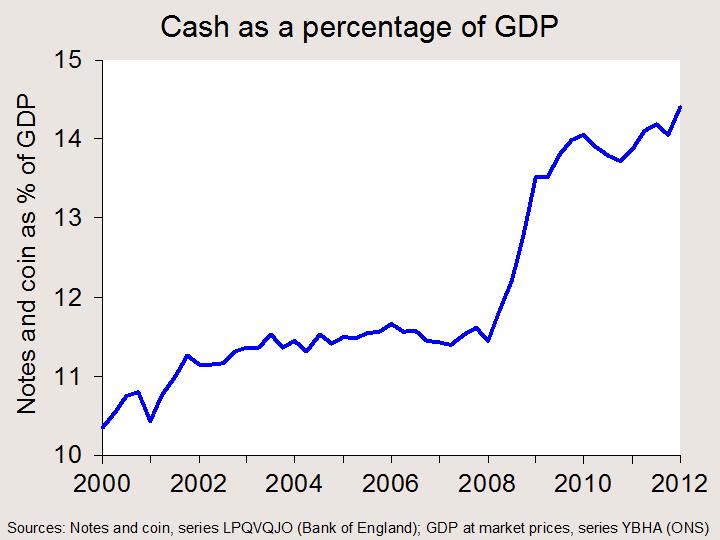
For a PowerPoint of the above chart, click here.
Questions
- What are the advantages and disadvantages of using cash?
- To what extent can mobile phone technology replace cash? What are the advantages and disadvantages of such technology?
- To what extent can mobile phone technology fulfil the various functions of money?
- Private-sector holdings of cash have been rising as a proportion of (nominal) GDP – see above chart. Is this consistent with a decreased use of cash? Explain.
- Why may mobile phone transactions be particularly useful in developing countries?
- What proportion of your own expenditure is conducted by cash? Has this changed over the past couple of years? If so, explain why.
The death of cash has long been forecast, but not yet happened, but is it the case that the next generation technology may finally sound the death knell? With the advent of prepaid cards (e.g. Oyster card in London), payment by mobiles and the continuing growth of ‘plastic’, it may be that cash is on an inexorable downward slide. The articles below look at a range of issues around the possible death of cash (and the introduction of the £20 note with Adam Smith on it).
Why I hate sticky electrons BBC News Online – Robert Peston Blog (19/2/07)
Cash used to be king, but now we pay for paying up Telegraph (9/2/07)
March launch for Smith £20 note BBC News Online (21/2/07)
A cash call The Economist (subscription) (15/2/07)
Questions
| 1. |
Explain the main functions that any form of money has to fulfil. |
| 2. |
Assess the extent to which smartcards (like the Oyster card) can fulfil these functions of money. |
| 3. |
Discuss the implications for the level of consumer spending of increased use of cash substitutes. |
 Latest data from the UK banking trade association, UK Finance, show that cash payments have continued to decline, while contactless and mobile payments have risen dramatically. In 2018, cash payments fell 16% to 11.0 billion payments and constituted just 28% of total payments; the compares with 60% in 2008 and a mere 9% projected for 2028. By contrast, in 2018, debit card payments increased 14% to 15.1 billion payments. Credit card payments increased 4% to stand at 3.2 billion payments. Mobile payments though media such as Apple Pay, Google Pay and Samsung Pay, although still a relatively small percentage, have also increased rapidly, with 16% of the adult population registered for mobile payments, compared with just 2% in 2016.
Latest data from the UK banking trade association, UK Finance, show that cash payments have continued to decline, while contactless and mobile payments have risen dramatically. In 2018, cash payments fell 16% to 11.0 billion payments and constituted just 28% of total payments; the compares with 60% in 2008 and a mere 9% projected for 2028. By contrast, in 2018, debit card payments increased 14% to 15.1 billion payments. Credit card payments increased 4% to stand at 3.2 billion payments. Mobile payments though media such as Apple Pay, Google Pay and Samsung Pay, although still a relatively small percentage, have also increased rapidly, with 16% of the adult population registered for mobile payments, compared with just 2% in 2016. Then there are benefits to vendors. Cashing up is time consuming and brings little or no benefit in terms of bank charges. These are typically around 0.75% for cash deposits and roughly the same for handling debit card payments (around 0.7%). What is more, with the closure of many bank branches, it is becoming harder for many businesses to deposit cash.
Then there are benefits to vendors. Cashing up is time consuming and brings little or no benefit in terms of bank charges. These are typically around 0.75% for cash deposits and roughly the same for handling debit card payments (around 0.7%). What is more, with the closure of many bank branches, it is becoming harder for many businesses to deposit cash.Because items purchased with a credit card have been decoupled from emotion, shoppers can focus on the benefits of the purchase instead of the cost. Thus, paying with a credit card makes it more difficult to focus on the cost or complete a more rational cost–benefit analysis. For example, if a person had to count out $0.99 to purchase an app, they might be less inclined to buy it. However, since we can quickly buy apps with our credit card, the cost seems negligible, and we can focus on the momentary happiness of the purchase.
 Cashless in China: Why It Matters
Cashless in China: Why It Matters 






